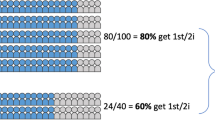Abstract
Limiting, or nonconforming cases are good tests in research for extending a concept’s reach and broadening generalisations, but the method is under utilised in the formation and assessment of educational policy. In this paper a rural town is described as a case, among others, not fitting policy regulations for “learning or earning” in Years 11 and 12 in Queensland. It is argued, through a description of the production and reproduction of the town’s service economy, that neither the curriculum nor the workforce can be placed within a theory of social and economic networking underpinning policies on retention and pathways upon which the Queensland legislation rests. Cases such as these are difficult to uncover because factors that best describe their true economic and social conditions tend to be compressed within statistical reporting models for educational regions. While the focus is on a rural town, the purpose is to advance policy design and implementation that seeks to sustain educational change in diverse conditions.
Similar content being viewed by others
References
Australian Bureau of Statistics (ABS). (2006).1216.0 — Australian standard geographical classification (ASGC). Retrieved 15 July 2008, from the Australian Bureau of Statistics Web site: http://www.abs.gov.au/AUSSTATS/abs@.nsf/be4aa82cd8cf7f07ca2570d6001 8da27/463f50115b6dccfbca2571a9001e1f44/$FILE/QLD.pdf
Baum, S., O’Connor, K., & Stimson, R. (2005).Fault lines exposed. Melbourne: Monash University ePress.
Becker, H. (1998).Tricks of the trade. Chicago: University of Chicago Press.
Bourdieu, P. (2000).Pascalian meditation. Oxford: Polity Press.
Bourdieu, P. (1984).Distinction: A social critique of the judgement of taste. (R. Nice, Trans.). Melbourne: Routledge & Kegan Paul. (Original work published 1984).
Cole, M. (1993, March).A Cultural — Historical Goal for Developmental Research: Create Sustainable Model Systems of Diversity. Paper presented at the 60th Meeting of the Society for Research and Child Development, New Orleans, LA.
Cole, P. R. (1937).The rural school in Australia. Melbourne: Melbourne University Press in association with Oxford University Press.
Coleman, J. S. (1988). Social capital in the creation of human capital.American Journal of Sociology 94, 95–120.
Edgar, D. (2001).The patchwork nation: Re-thinking government — Re-building Community. Pymble, NSW: Harper Collins.
Eldridge, D. (Chair) (2001).Footprints to the future: Report of the Prime Minister’s Youth Pathways Action Plan Taskforce. Canberra: Department of Education, Training and Youth Affairs.
Finn, B. (1991).Young peoples’ participation in post pompulsory education and Training. Melbourne: Australian Education Council.
Flyvberg, B. (2001).Making social science matter. Cambridge: University of Cambridge Press.
Funnell, R., & Tully, T. (2004). Developing and sustaining education programs that matter for remote communities. In P. Jeffery (Ed.),Doing the public good. Melbourne: Australian Association for Research in Education.
Granovetter, M. S. (1973). The strength of weak ties.The American Journal of Sociology, 78(6), 1360–1380.
Homel, R. (1999).Pathways to prevention: Developmental and early intervention approaches to crime in Australia. Canberra: National Crime Prevention, Attorney-General’s Department.
Lamb, S., Walstab, A., Teese, R., Vickers, M., & Rumberger, R. (2004).Staying on at school: Improving student retention in Australia. Retrieved April 2005, from the Queensland Department for Education and the Arts Web site: http://education.qld.gov.au/publication/production/reports/index.html.
Putnam, R. D. (2000).Bowling alone. The collapse and revival of American Community. New York: Simon and Schuster.
Queensland Government. (2007).Next Step: A report on the destinations of Year 12 completers from 2006 in the region of Darling Downs/South West. Queensland: Department of Education, Training and the Arts.
Queensland Government. (2006).Youth participation in education and training act. Education (General Provisions) Bill 2006. Retrieved September 5, 2006, from the Queensland Government Web site: http://www.legislation.qld.gov.au/Bills/51PDF/ 2006/EducGenProvB06.pdf
Raffe, D. (2001). Pathways linking education and work: A review of concepts, research, and policy debates.Journal of Youth Studies, 6 (1), 3–19.
Sher, J. P., & Sher, K. R. (1994). Beyond the conventional wisdom: Rural development as if Australia’s rural people and communities really mattered.Journal of Research in Rural Education, 10(1), 2–43.
Spierings, J. (2000).Developing a new regional education, employment and training agenda: Early lessons from Whittlesea. Sydney: Dusseldorp Skills Forum.
Teese, R. (1998). Curriculum hierarchy, private schooling, and the segmentation of Australian secondary education, 1947–1985.British Journal of Sociology of Education, 19(3), 401–417.
Victorian Department of Justice (1997).Safer cities and shires: A guide to developing strategic partnerships. Victoria: Victorian department of justice.
Author information
Authors and Affiliations
Rights and permissions
About this article
Cite this article
Funnell, R. “Finding what doesn’t fit”: Adjusting the focus on education in country towns as a limiting case for the “learning or earning” years. Aust. Educ. Res. 35, 107–122 (2008). https://doi.org/10.1007/BF03216886
Issue Date:
DOI: https://doi.org/10.1007/BF03216886




